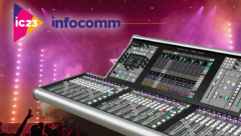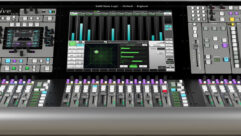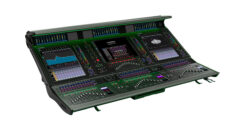
Mixing Live with RML Labs’ Software Audio Console, Part 2
May 18, 2012 10:06 AM,
WIth Bennett Liles
Listen to the Podcasts
Editor’s note: For your convenience, this transcription of the podcast includes timestamps. If you are listening to the podcast and reading its accompanying transcription, you can use the timestamps to jump to any part of the audio podcast by simply dragging the slider on the podcast to the time indicated in the transcription.
Mixing on a computer isn’t that exotic, but if you do it live, things can get more interesting. At the Goodlettsville Church of the Nazarene, the price of big time digital mixers was out of reach, so Keith Sealy fires up the Software Audio Console and mixes the services live. He’s here to tell us how it’s done, right now on the SVC Podcast.
SVC: Keith Sealy, thanks for being back with us on the SVC Podcast from the Goodlettsville Church of the Nazarene up there in Tennessee, up near Nashville. And in part one we were talking about mixing with Software Audio Console and doing this live. A lot of people are used to this idea in post, but the thought of doing it live might cause a few double takes. So run through the signal flow on your setup. How does the original audio get to the mixed output?
Keith Sealy: With the Software Audio Console, like I said we’re using the Behringer mic pres, and so it comes into the Behringer mic pres. It comes out of those optically and we’re feeding the MOTU 2408 cards and we have two of those to get us to 48 in and out. It’s all done optically after it leaves the Behringer mic pres and then from there it just—from there we’ve got some Behringer Ultra-Drive drive rack processors that hit our main speakers but it’s really simple in and out. Everything’s done optically for us. [Timestamp: 1:42]
And I saw some YouTube videos that you told us about last time and some of those are really interesting. Some show people using the Behringer BCF 2000 as the control surface. Is that what you’re doing?
That’s what we’re doing. We have two of them. We chose to do two and the way our setup is we have two flat screen monitors, we actually had three but one of them sits right in front of the BCF2000 and so showing on the screen are eight of the individual channels that correspond with the fader pack below it and then we have another monitor that does the same thing so we have access to 16 channels with faders at any one time and the we have another screen that’s an HD screen and it shows our other 40 input so if we click on them real quickly we can get to those if we need to. But we’re using 16 faders at this given time. And its, I was actually a little concerned about that when we decided to do that but after using it and the way we have our system set up, like I said, mixing basically off the DCA’s it has not been a problem what so ever. [Timestamp: 2:44]
And what’s the size on those monitors that you’re using at the church?
I believe those two are 15 in. monitors. They’re either 15 or 17—I believe they’re 15 in. They’re just normal little square monitors, SD monitors. [Timestamp: 2:55]
Yeah, those will fit just about anywhere.
Yeah.
I was thinking it would have to be a huge one. On the YouTube videos, it was a considerably bigger monitor that was being used.
Yeah and like I said our third monitor is probably, it’s probably like a 21 in. or so because we wanted it wider so we could show more channels at any given time but for those 16 right in the middle we just need eight on a monitor per page and it’s a good size, it’s easy to see you don’t have to really get into it to really see what you’re looking at. [Timestamp: 3:21]
On your setup in the church, where exactly are you and how far are you from the performing area?
The way the Software Audio Console works is you have a main control unit or a main computer and for that that’s where all of our mic pre’s are and the interfaces and that actually sits on the stage back stage. Our stage is set up so we have a drape all the way around it and it’s set up back stage like in monitor world would be and then FOH is probably about 45 ft. out dead center of the stage and so we, through TCP/IP we use, we connect to the main computer and so basically what we’re using out front is a remote to the main computer on the stage. [Timestamp: 4:00]
OK and you’ve got a lot of live music going on there. We were talking about that before. How do you handle stage monitoring for all that?
This was another big selling point for us. It will do a FOH mix set up and then you also have 24, I believe it’s 24, additional mixers that you can use for a monitor world which gives you all those inputs right in front of whoever’s mixing it. Like I said its 25—24 different mixers I believe. But for us, we’re only using about four of those other mixers because our band uses the Aviom system and really the only reason we’re on the Aviom is because we—it wasn’t long ago we bought those and it’s a great system but you could use the SAC for your band guys just hand them a laptop or something in a way to get audio through some type of headphone system and they could pull up every input that we’re seeing out front, EQ it, do whatever they want with it without affecting FOH monitors. So that’s the way we’re set up though is through the Aviom’s. [Timestamp: 5:01]
Mixing Live with RML Labs’ Software Audio Console, Part 2
May 18, 2012 10:06 AM,
WIth Bennett Liles
Yeah and that way your band guys can be pretty well self sufficient on what they’re listening to.
Exactly and they give you, for the monitors side of things, it gives you many different ways to how you want to see the signal whether it’s pre-fader, post-fader, from FOH, I think you can do pre-patch point, pre-EQ, there’s a lot of different combinations you can get to give to the monitor side of the sack audio console. [Timestamp: 5:25]
One big question I know people are wondering about. What kind of processing do you really need for a setup like this?
We actually built our computer and on their website—again, it’s a really good website—it gives you a lot of good information and they have a what they suggest for their computers so we try to stay as close to that as we could but we’re using, I believe it’s a I3CPU processor 3.1 GHz and then we’re only running I think four gigs of ram of memory in it and then just a small hard drive because the hard drive is not doing anything except saving files. I think it’s like a 60 gig hard drive. And then also that’s the only the thing on that computer because we didn’t put anything else, they don’t recommend you put anything else on it because we want it just to run audio. We don’t want it to do anything else and because of that it’s been very reliable. We have had no issues with lock up or anything like that, the only problem we’ve had is we lost our TCP/IP connection one week. The thing kept running though because the main computer is what’s actually running the console and the audio we just couldn’t control it but we were able to solve that pretty quickly and to be honest with you we also, something I haven’t told you, we have a system in the FOH also where we have a totally separate computer that is talking to our main frame wirelessly just set up as another remote so when we lost that TCP connection we were actually able to reach, go over to our other little computer and wirelessly was still there. It’s very reliable and like I said we put nothing else on that computer we just strictly let it only run software audio console. [Timestamp: 7:10]
What have you got in the way of plug-ins on this setup?
You know, we’re not actually using a lot of plug-in’s. It comes with a pretty good EQ, it’s got compression, it’s got gating on every channel, the only plug-in we demo’d and we just ended up not buying it at the present time is the reverb on it because it has, it actually has a delay on it that you can do tap delay on it, it’s got some graphic EQ’s on it that came with it. The only reason we didn’t do the reverb is we have some Lexicon units and we really like those so we just decided to keep those and run, just bring them back in whatever inputs we have room for. [Timestamp: 7:36]
I’d say that’s one of the big advantages on something like this. You don’t have as much hardware and it’s easier to custom tailor it. That’s the upside anyway. Is there a particular downside to doing this, any kind of challenges that you’ve had to get used to on doing it this way?
You know, I can’t say there really is. We’ve been very happy with it. We really like that there’s not a lot of pages that you have to go through like on some of the digital consoles and you can get to things really quickly which is a plus. If an acoustic guitar starts ringing out, I’m a mouse click away from being able to grab it, grab the EQ, bring the whole set up on it right up on screen and address the problem. So in the old days if we had compressors and stuff they were usually in the bottom of the rack so you would have to lean down. With this it’s all right in your face. I can’t think of any disadvantages really. [Timestamp: 8:24]
And I would think that you have to teach some of the other crew people how to operate all of this.
Yeah, we’ve—we don’t have many audio guys. We have one guy that pretty much is our FOH audio every week if he can’t be there usually it falls to me or if we have other events going on in the week I’ll do it and then we have one other guy who is a—he’s also a studio engineer here in town. We’re very blessed actually. And he actually ran it by himself a couple weeks ago and he had no issues either. We even have it set up so that when the computer boots it boots up into Software Audio Console. It’s literally like just flipping the power switch on an analog console and then for us we open the file that we want and it goes live and it’s just like any other console. [Timestamp: 9:07]
So you eventually get more people in there or you get a bigger band or whatever, what are you going to stick on it? What’s first on your wish list about adding to this thing?
As far as the console, the only thing I could see we might add would be maybe some more inputs if we started doing more with the way we wanted to record. With this console also you can run the SAWStudio software which would give you a digital recorder basically and that’s something we might add at some point so that we could record our services each and every week and then go back and mix them at a later date and so that would be one thing we would probably add in the future. [Timestamp: 9:42]
Well, for financially challenged churches wanting to get into the digital age this certainly is a very interesting option. Mixing live with the Software Audio Console and the various hardware variations that go with it. I appreciate your telling us about it Keith.
Yeah, I appreciate the opportunity.
Keith Sealy from the Goodlettsville Church of the Nazarene. Thanks for being here and good luck on future additions to this.
I appreciate it. I appreciate you having us.










